Quantitative Power Flow Characterization of Energy Harvesting Shock Absorbers by Considering Motion Bifurcation
Abstract
1. Introduction
- (1)
- A novel numerical iterative method was proposed that fills in the blanks from the theoretical solution for MMR−EHSAs with random vibration input. Based on the proposed theoretical model, the power flow of MMR−EHSAs in different working states is established. Through the power flow model, the working effect of MMR−EHSAs can be effectively evaluated in the preliminarily stages, which helps the design and application of MMR−EHSAs.
- (2)
- The working characteristics of MMR−EHSAs are demonstrated by studying common harmonic excitation. The optimal damping force resistance is revealed. The power flow model can obtain the optimal energy harvesting resistance.
2. Design and Working Principle
3. Nonlinear Dynamics Model of MMR−EHSAs
3.1. Nonlinear Total Damping Force Model of MMR−EHSAs
3.2. Numerical Iterative Motion Bifurcation Model of MMR−EHSAs
3.3. Analytical Motion Bifurcation Model of MMR−EHSAs
3.4. Quantitative Power Flow Model of MMR−EHSAs
4. Test Bench
4.1. Experimental Setup
4.2. Experimental Results and Analysis
5. Quantitative Power Flow Discussion
5.1. Quantitative Power Flow Analysis within a Harmonic Cycle
5.2. Average Power Analysis of Different Resistances
5.3. The Theoretical Model Solves for Random Vibration
6. Conclusions
Author Contributions
Funding
Data Availability Statement
Conflicts of Interest
References
- Bucinskas, V.; Mitrouchev, P.; Sutinys, E.; Sesok, N.; Iljin, I.; Morkvenaite-Vilkonciene, I. Evaluation of Comfort Level and Harvested Energy in the Vehicle Using Controlled Damping. Energies 2017, 10, 1742. [Google Scholar] [CrossRef]
- Lee, J.; Chun, Y.; Kim, J.; Park, B. An Energy-Harvesting System Using Mppt at Shock Absorber for Electric Vehicles. Energies 2021, 14, 2552. [Google Scholar] [CrossRef]
- Gijón-Rivera, C.; Olazagoitia, J.L. Methodology for Comprehensive Comparison of Energy Harvesting Shock Absorber Systems. Energies 2020, 13, 6110. [Google Scholar] [CrossRef]
- Duong, M.T.; Chun, Y.D.; Hong, D.K. Design of a High-Performance 16-Slot 8-Pole Electromagnetic Shock Absorber Using a Novel Permanent Magnet Structure. Energies 2018, 11, 3352. [Google Scholar] [CrossRef]
- Zou, H.X.; Zhao, L.C.; Gao, Q.H.; Zuo, L.; Liu, F.R.; Tan, T.; Wei, K.X.; Zhang, W.M. Mechanical Modulations for Enhancing Energy Harvesting: Principles, Methods and Applications. Appl. Energy 2019, 255, 113871. [Google Scholar] [CrossRef]
- Zou, H.X.; Li, M.; Zhao, L.C.; Gao, Q.H.; Wei, K.X.; Zuo, L.; Qian, F.; Zhang, W.M. A Magnetically Coupled Bistable Piezoelectric Harvester for Underwater Energy Harvesting. Energy 2021, 217, 119429. [Google Scholar] [CrossRef]
- Qian, J.; Jing, X. Wind-Driven Hybridized Triboelectric-Electromagnetic Nanogenerator and Solar Cell as a Sustainable Power Unit for Self-Powered Natural Disaster Monitoring Sensor Networks. Nano Energy 2018, 52, 78–87. [Google Scholar] [CrossRef]
- Guan, D.; Cong, X.; Li, J.; Shen, H.; Zhang, C.; Gong, J. Quantitative Characterization of the Energy Harvesting Performance of Soft-Contact Sphere Triboelectric Nanogenerator. Nano Energy 2021, 87, 106186. [Google Scholar] [CrossRef]
- Liang, C.; Ai, J.; Zuo, L. Design, Fabrication, Simulation and Testing of an Ocean Wave Energy Converter with Mechanical Motion Rectifier. Ocean Eng. 2017, 136, 190–200. [Google Scholar] [CrossRef]
- Bowen, L.V. Design and Potential Power Recovery of Two Types of Energy Harvesting Shock Absorbers. Energies 2019, 12, 4710. [Google Scholar] [CrossRef]
- Guan, D.; Cong, X.; Li, J.; Wang, P.; Yang, Z.; Jing, X. Theoretical Modeling and Optimal Matching on the Damping Property of Mechatronic Shock Absorber with Low Speed and Heavy Load Capacity. J. Sound Vib. 2022, 535, 117113. [Google Scholar] [CrossRef]
- Vasic, D.; Chen, Y.Y.; Costa, F. Self-Powered Piezoelectric Energy Harvester for Bicycle. J. Mech. Sci. Technol. 2014, 28, 2501–2510. [Google Scholar] [CrossRef]
- Abdelkareem, M.A.A.; Xu, L.; Ali, M.K.A.; Elagouz, A.; Mi, J.; Guo, S.; Liu, Y.; Zuo, L. Vibration Energy Harvesting in Automotive Suspension System: A Detailed Review. Appl. Energy 2018, 229, 672–699. [Google Scholar] [CrossRef]
- Bowen, L.; Vinolas, J.; Olazagoitia, J.L.; Echavarri Otero, J. An Innovative Energy Harvesting Shock Absorber System Using Cable Transmission. IEEE/ASME Trans. Mechatron. 2019, 24, 689–699. [Google Scholar] [CrossRef]
- Molina Arias, L.; Iwaniec, J.; Iwaniec, M. Modeling and Analysis of the Power Conditioning Circuit for an Electromagnetic Human Walking-Induced Energy Harvester. Energies 2021, 14, 3367. [Google Scholar] [CrossRef]
- Hong, Y.; Temiz, I.; Pan, J.; Eriksson, M.; Boström, C. Damping Studies on Pmlg-Based Wave Energy Converter under Oceanic Wave Climates. Energies 2021, 14, 920. [Google Scholar] [CrossRef]
- Jintanawan, T.; Phanomchoeng, G.; Suwankawin, S.; Kreepoke, P.; Chetchatree, P.; U-Viengchai, C. Design of Kinetic-Energy Harvesting Floors. Energies 2020, 13, 5419. [Google Scholar] [CrossRef]
- Wu, X.; Qi, L.; Zhang, T.; Zhang, Z.; Yuan, Y.; Liu, Y. A Novel Kinetic Energy Harvester Using Vibration Rectification Mechanism for Self-Powered Applications in Railway. Energy Convers. Manag. 2021, 228, 113720. [Google Scholar] [CrossRef]
- Zhang, Z.; Zhang, X.; Chen, W.; Rasim, Y.; Salman, W.; Pan, H.; Yuan, Y.; Wang, C. A High-Efficiency Energy Regenerative Shock Absorber Using Supercapacitors for Renewable Energy Applications in Range Extended Electric Vehicle. Appl. Energy 2016, 178, 177–188. [Google Scholar] [CrossRef]
- Li, Z.; Zuo, L.; Kuang, J.; Luhrs, G. Energy-Harvesting Shock Absorber with a Mechanical Motion Rectifier. Smart Mater. Struct. 2013, 22, 025008. [Google Scholar] [CrossRef]
- Li, Z.; Zuo, L.; Luhrs, G.; Lin, L.; Qin, Y.X. Electromagnetic Energy-Harvesting Shock Absorbers: Design, Modeling, and Road Tests. IEEE Trans. Veh. Technol. 2013, 62, 1065–1074. [Google Scholar] [CrossRef]
- Guo, S.; Liu, Y.; Xu, L.; Guo, X.; Zuo, L. Performance Evaluation and Parameter Sensitivity of Energy-Harvesting Shock Absorbers on Different Vehicles. Veh. Syst. Dyn. 2016, 54, 918–942. [Google Scholar] [CrossRef]
- Xie, L.; Cai, S.; Huang, G.; Huang, L.; Li, J.; Li, X. On Energy Harvesting from a Vehicle Damper. IEEE/ASME Trans. Mechatron. 2020, 25, 108–117. [Google Scholar] [CrossRef]
- Xie, L.; Li, J.; Li, X.; Huang, L.; Cai, S. Damping-Tunable Energy-Harvesting Vehicle Damper with Multiple Controlled Generators: Design, Modeling and Experiments. Mech. Syst. Signal Process. 2018, 99, 859–872. [Google Scholar] [CrossRef]
- Zhu, H.; Li, Y.; Shen, W.; Zhu, S. Mechanical and Energy-Harvesting Model for Electromagnetic Inertial Mass Dampers. Mech. Syst. Signal Process. 2019, 120, 203–220. [Google Scholar] [CrossRef]
- Liu, Y.; Xu, L.; Zuo, L. Design, Modeling, Lab, and Field Tests of a Mechanical-Motion-Rectifier-Based Energy Harvester Using a Ball-Screw Mechanism. IEEE/ASME Trans. Mechatron. 2017, 22, 1933–1943. [Google Scholar] [CrossRef]
- Li, X.; Liang, C.; Chen, C.A.; Xiong, Q.; Parker, R.G.; Zuo, L. Optimum Power Analysis of a Self-Reactive Wave Energy Point Absorber with Mechanically-Driven Power Take-Offs. Energy 2020, 195, 116927. [Google Scholar] [CrossRef]
- Lin, T.; Wang, J.J.; Zuo, L. Efficient Electromagnetic Energy Harvester for Railroad Transportation. Mechatronics 2018, 53, 277–286. [Google Scholar] [CrossRef]
- Yuan, Y.; Liu, M.; Tai, W.C.; Zuo, L. Design and Treadmill Test of a Broadband Energy Harvesting Backpack with a Mechanical Motion Rectifier. J. Mech. Des. Trans. ASME 2018, 140, 1–8. [Google Scholar] [CrossRef]
- Yang, Y.; Pian, Y.; Liu, Q. Design of Energy Harvester Using Rotating Motion Rectifier and Its Application on Bicycle. Energy 2019, 179, 222–231. [Google Scholar] [CrossRef]
- Wang, Z.; Zhang, T.; Zhang, Z.; Yuan, Y.; Liu, Y. A High-Efficiency Regenerative Shock Absorber Considering Twin Ball Screws Transmissions for Application in Range-Extended Electric Vehicles. Energy Built Environ. 2020, 1, 36–49. [Google Scholar] [CrossRef]
- Li, H.; Zheng, P.; Zhang, T.; Zou, Y.; Pan, Y.; Zhang, Z.; Azam, A. A High-Efficiency Energy Regenerative Shock Absorber for Powering Auxiliary Devices of New Energy Driverless Buses. Appl. Energy 2021, 295, 117020. [Google Scholar] [CrossRef]
- Salman, W.; Qi, L.; Zhu, X.; Pan, H.; Zhang, X.; Bano, S.; Zhang, Z.; Yuan, Y. A High-Efficiency Energy Regenerative Shock Absorber Using Helical Gears for Powering Low-Wattage Electrical Device of Electric Vehicles. Energy 2018, 159, 361–372. [Google Scholar] [CrossRef]
- Li, X.; Martin, D.; Liang, C.; Chen, C.A.; Parker, R.G.; Zuo, L. Characterization and Verification of a Two-Body Wave Energy Converter with a Novel Power Take-off. Renew. Energy 2021, 163, 910–920. [Google Scholar] [CrossRef]
- Costanzo, L.; Lin, T.; Lin, W.; Schiavo, A.L.; Vitelli, M.; Zuo, L. Power Electronic Interface with an Adaptive MPPT Technique for Train Suspension Energy Harvesters. IEEE Trans. Ind. Electron. 2020, 68, 8219–8230. [Google Scholar] [CrossRef]
- Guo, S.; Xu, L.; Liu, Y.; Guo, X.; Zuo, L. Modeling and Experiments of a Hydraulic Electromagnetic Energy-Harvesting Shock Absorber. IEEE/ASME Trans. Mechatron. 2017, 22, 2684–2694. [Google Scholar] [CrossRef]


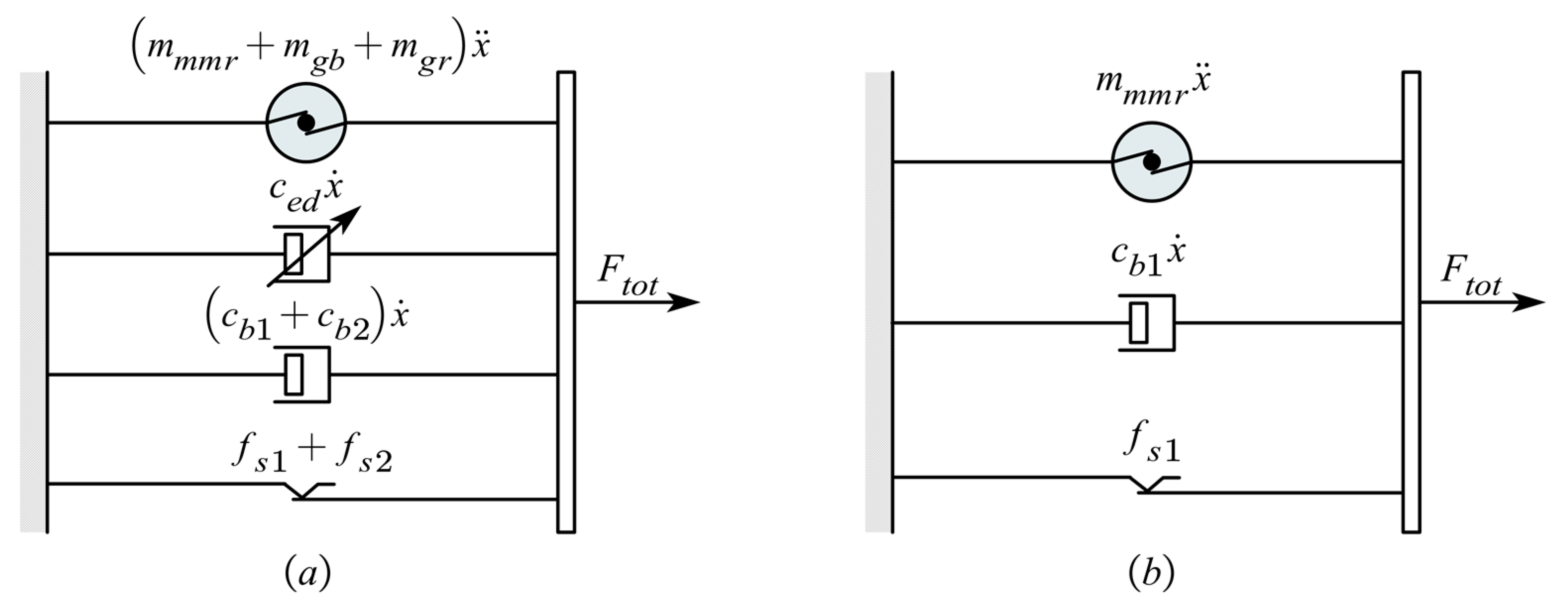
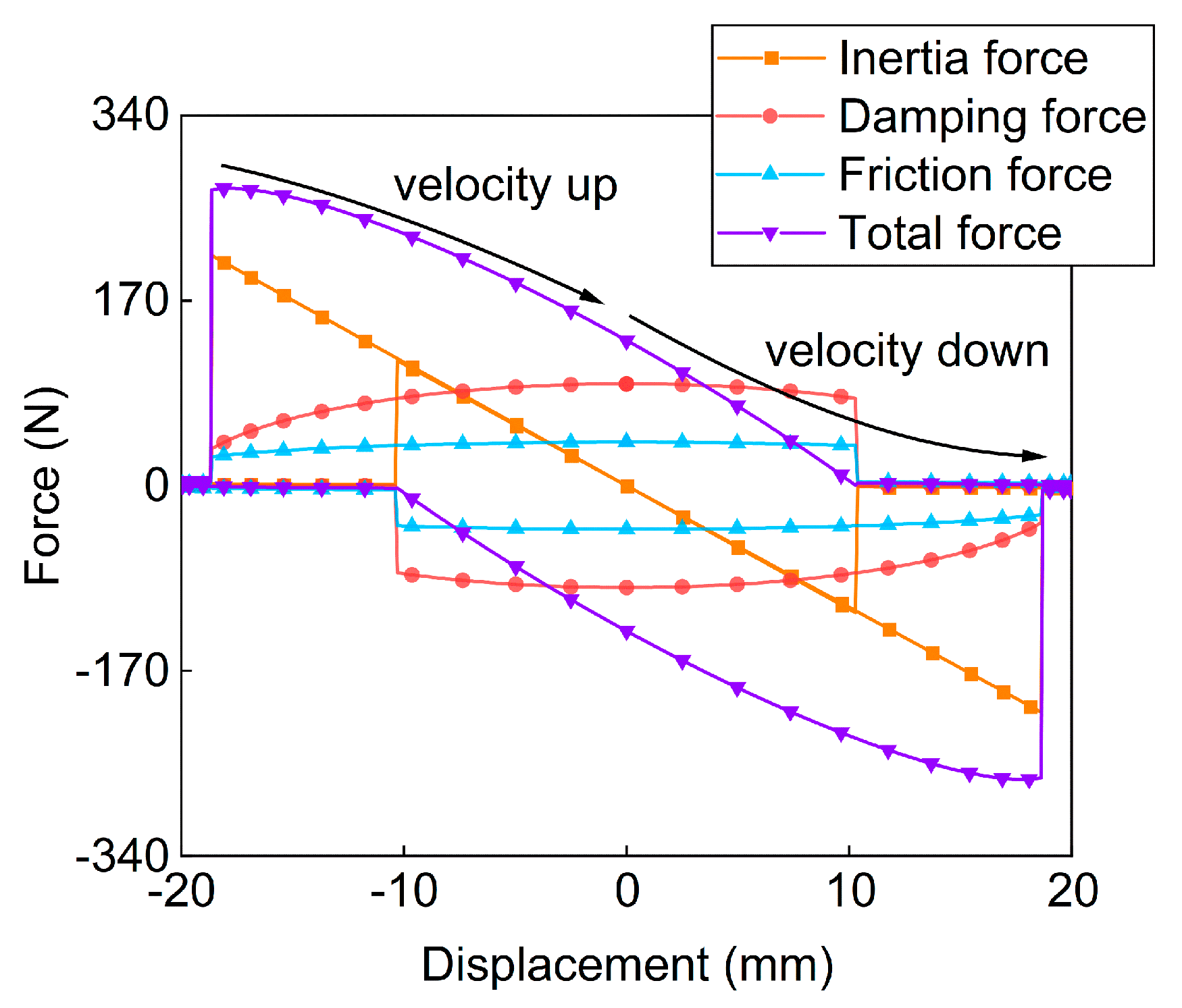
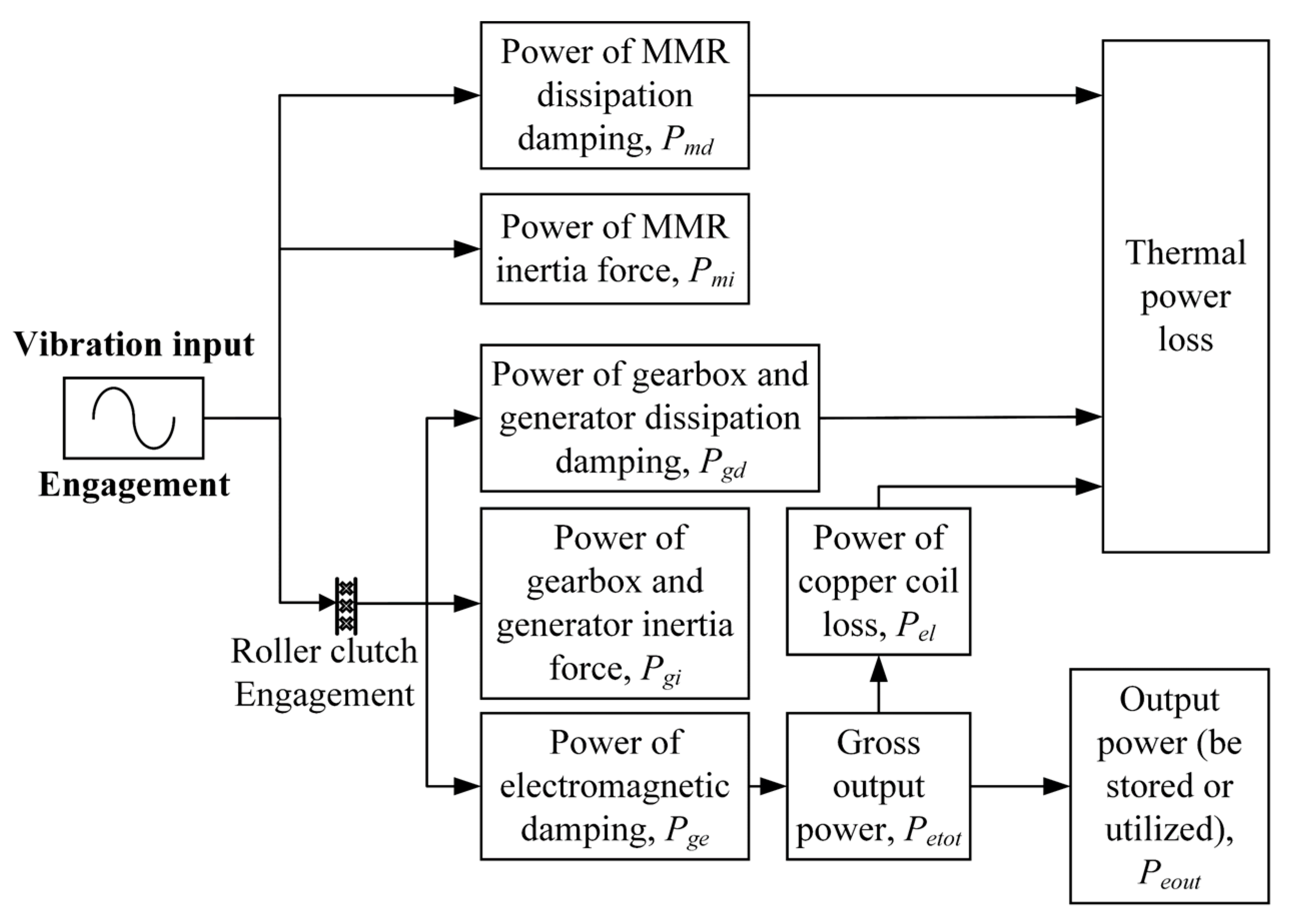
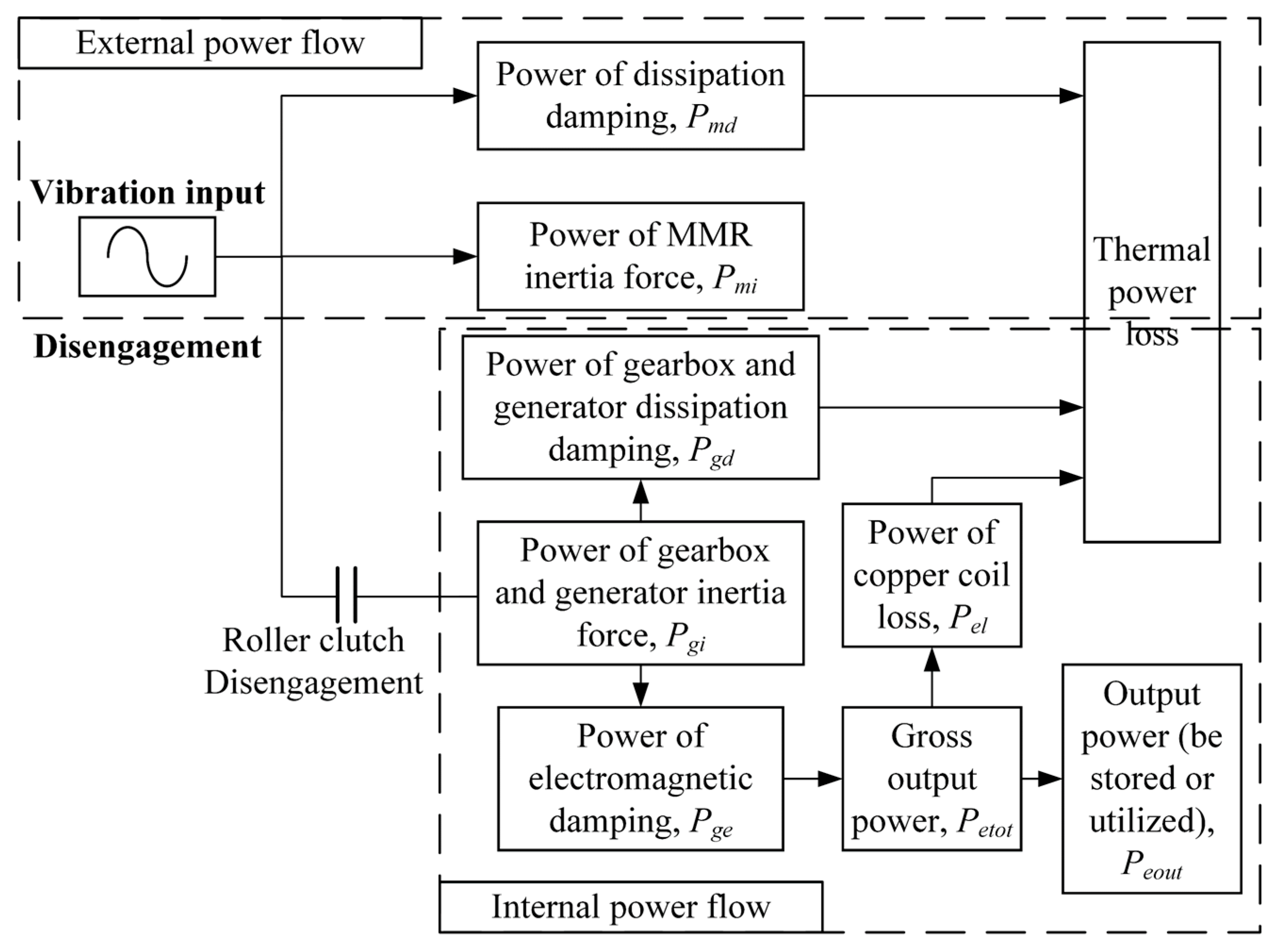

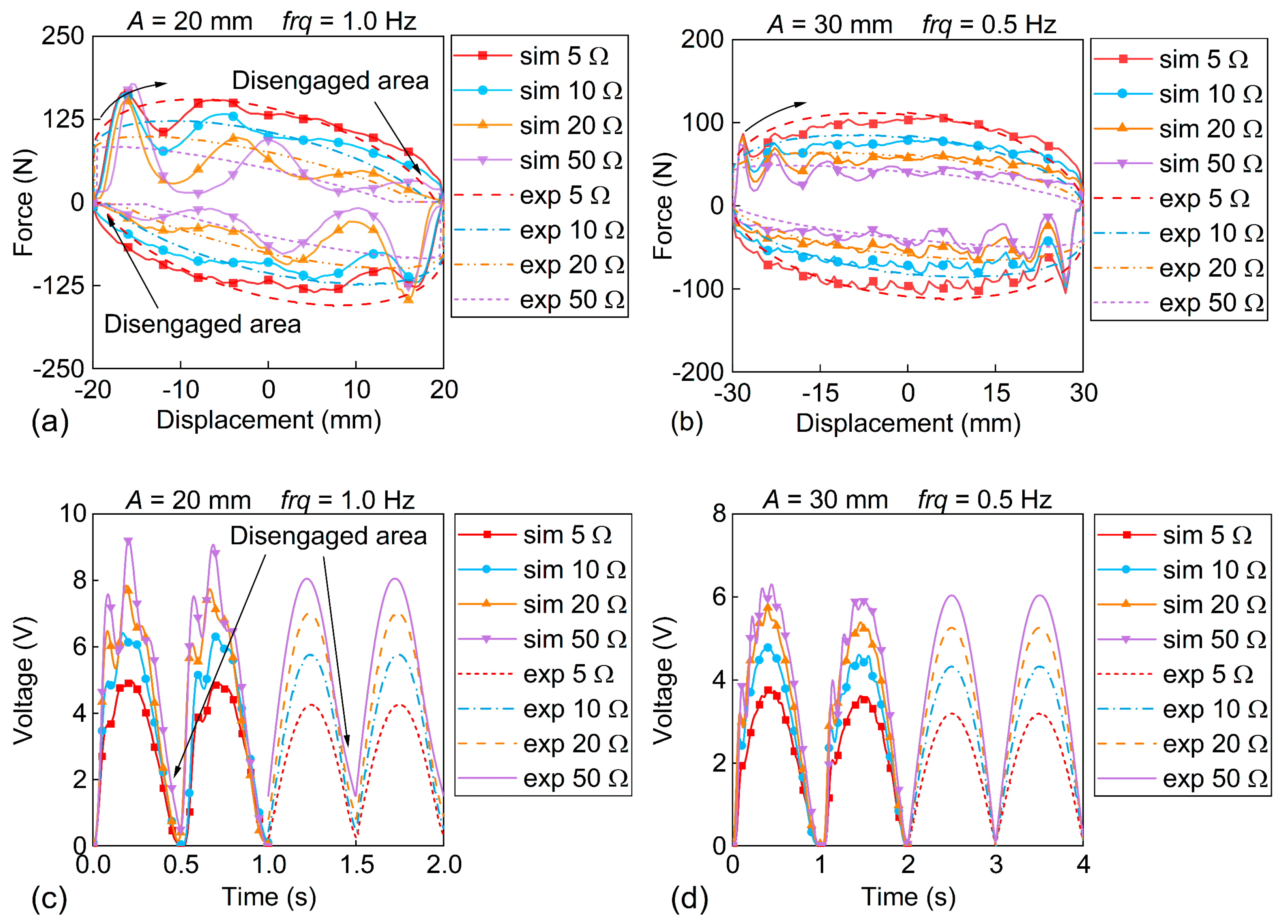
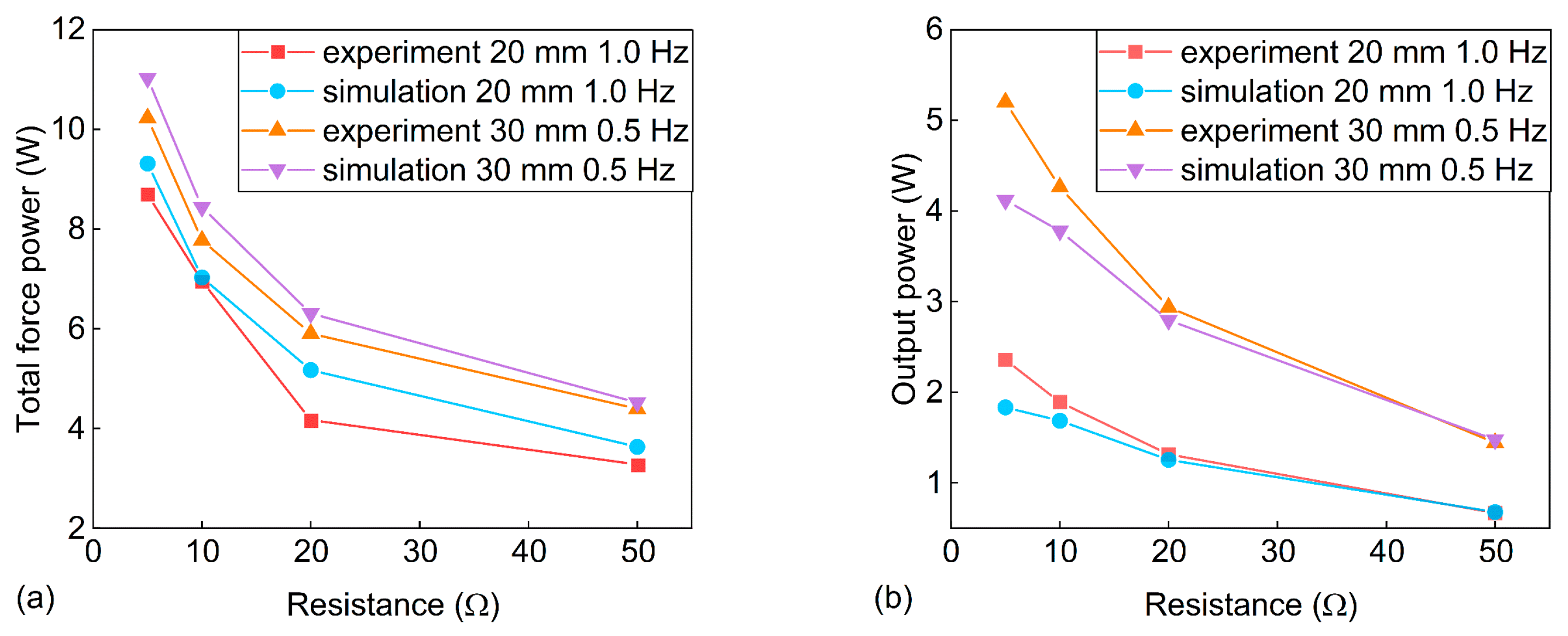

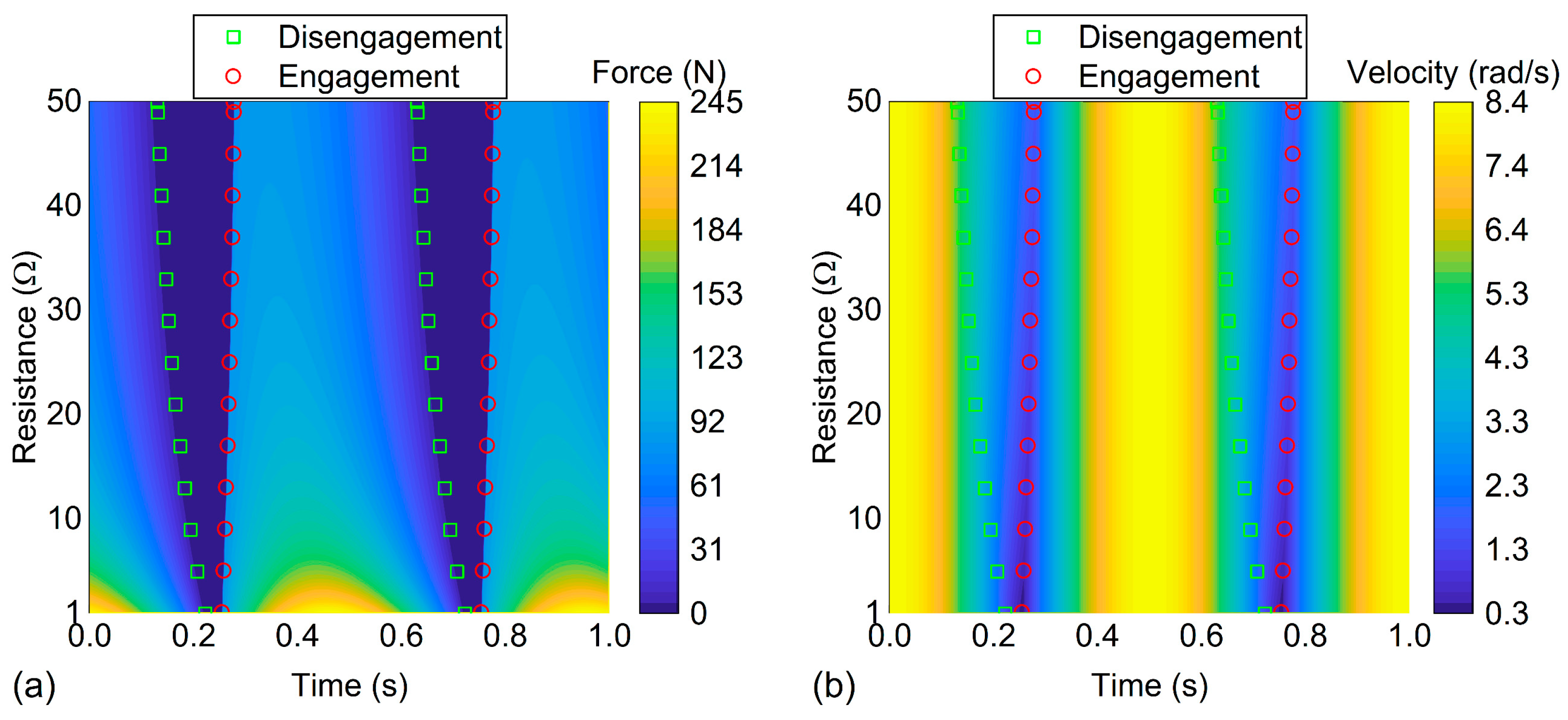
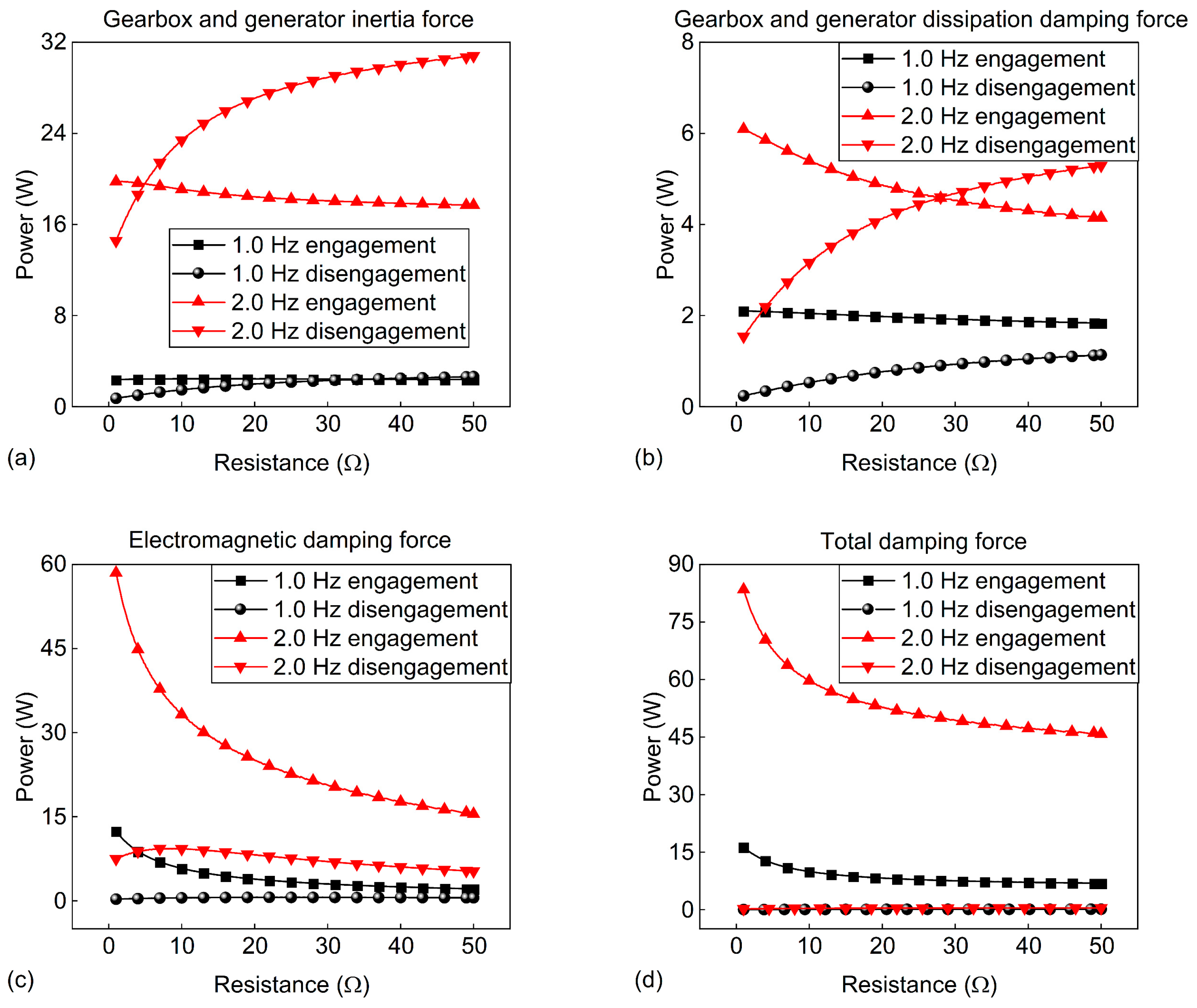
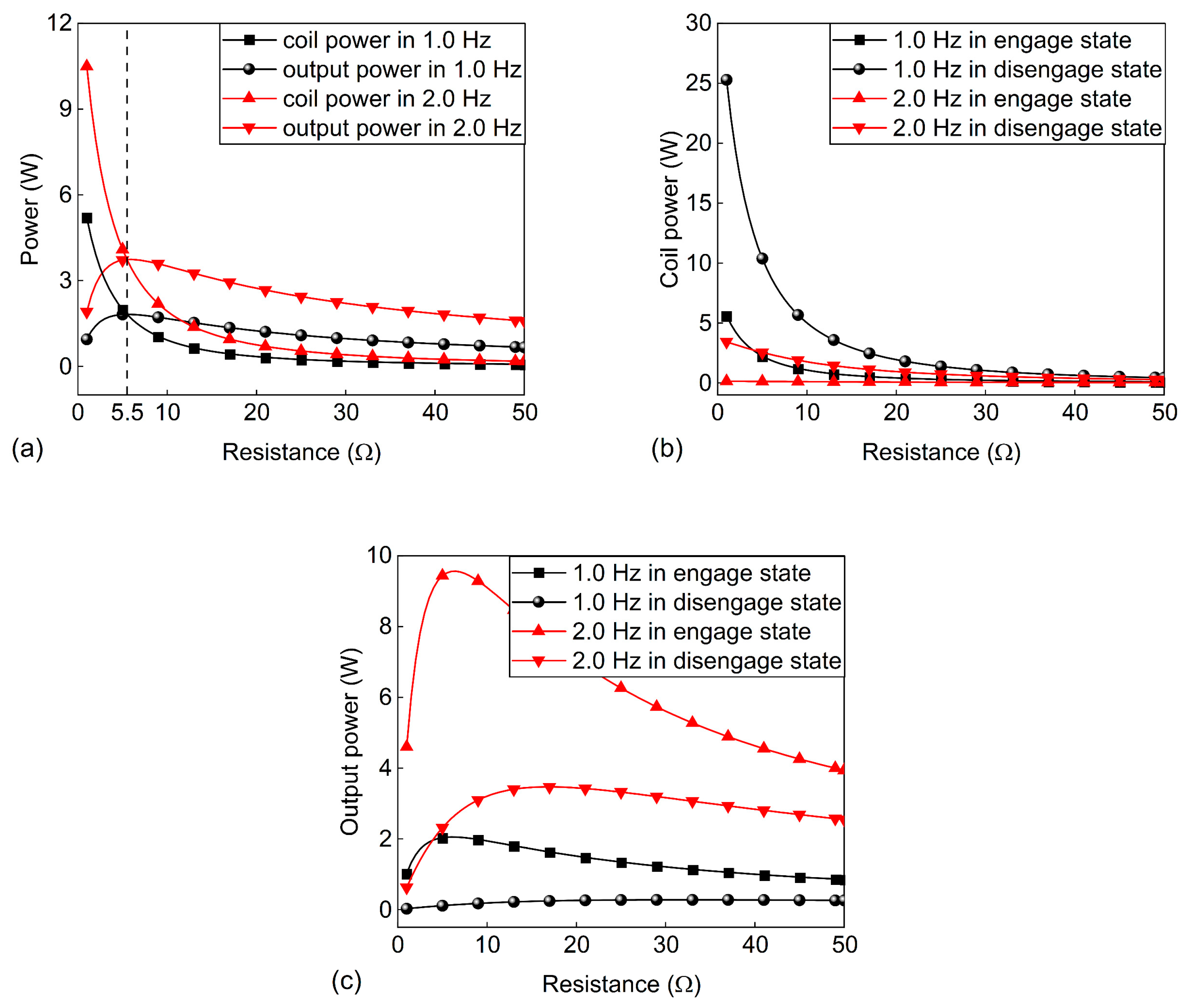
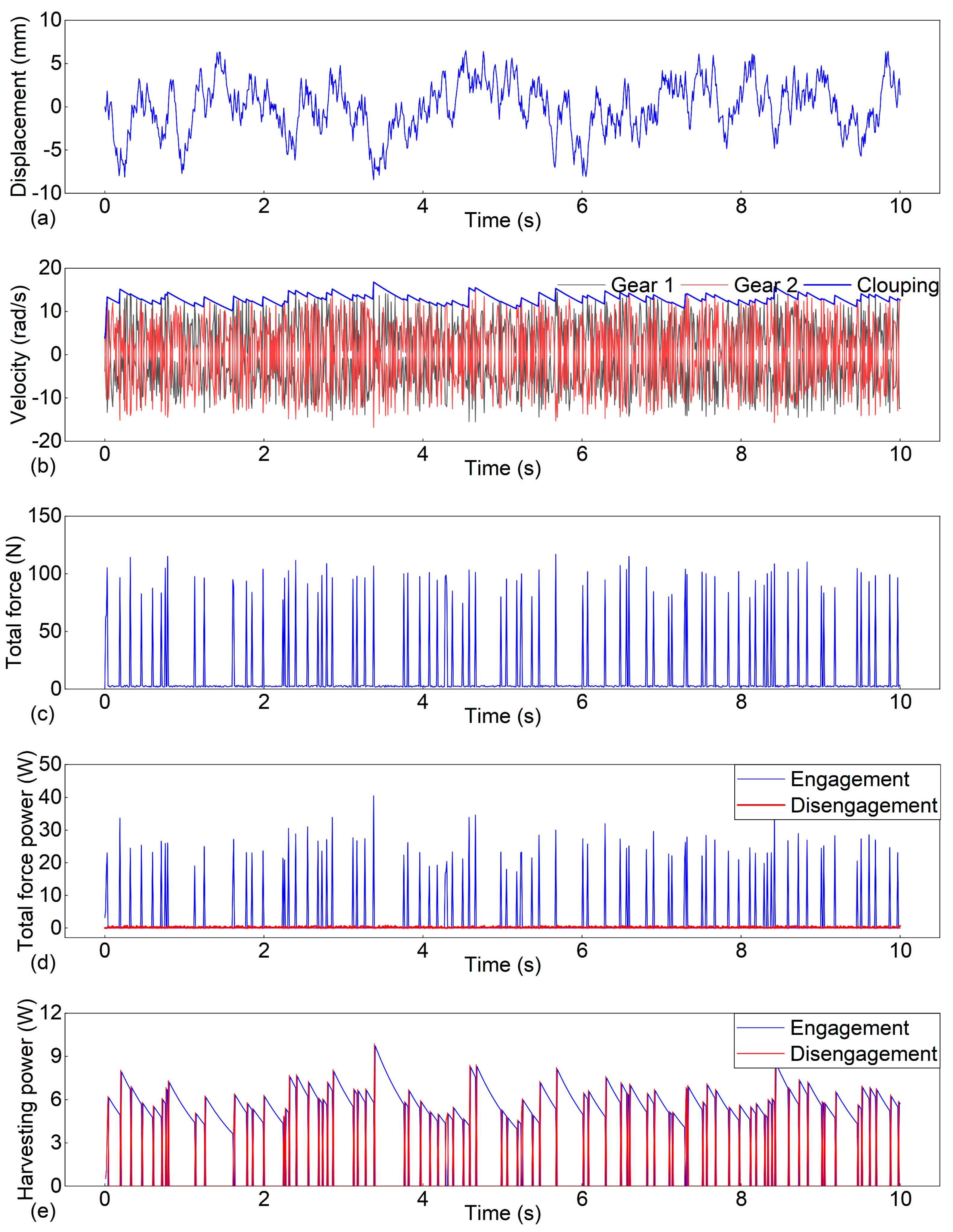
| Symbol | Value | Physical Understanding |
|---|---|---|
| mr | 0.491 kg | inertia coefficient of the rack |
| Jg1 | 7.066 × 10−6 kg∙m2 | rotational inertia of gear 1 |
| Jg2 | 7.066 × 10−6 kg∙m2 | rotational inertia of gear 2 |
| Jg3 | 7.066 × 10−6 kg∙m2 | rotational inertia of gear 3 |
| Jc | 8.106 × 10−6 kg∙m2 | rotational inertia of the coupling |
| Jgr | 32.212 × 10−6 kg∙m2 | rotational inertia of the generator |
| igb | 0.045 | transmission ratio of the gearbox |
| rg | 15 mm | gear radius |
| ke | 0.048 V/rad | back electromotive voltage constant |
| kt | 0.090 N∙m/A | torque constant |
| Rcoil | 5.5 Ω | resistance of the generator coil |
| fs1 | 1.7 N | slide friction force of the MMR |
| fs2 | 17.06 N | slide friction force of the gearbox and generator |
| cb1 | 7.5 N∙s/m | equivalent mechanical damping coefficient of the MMR |
| cb2 | 75.6 N∙s/m | equivalent mechanical damping coefficient of the gearbox and generator |
| n00 | 0.011 m−1 | cutoff frequency |
| u | 16.67 m/s | horizontal movement velocity |
| Sq(n0) | 64 × 10−6 m3 | roughness index |
| Time | Input | Coupling Virtual Velocity | Bifurcation Threshold | Coupling Velocity | Coupling Acceleration |
|---|---|---|---|---|---|
| t0 | |||||
| t1 | |||||
| … … | |||||
| tn | |||||
| 4.5 Ω | 5.0 Ω | 5.5 Ω | 6.0 Ω | 6.5 Ω | 7.0 Ω | |
|---|---|---|---|---|---|---|
| 1 Hz | 1.8005 W | 1.8148 W | 1.8193 W | 1.8161 W | 1.8073 W | 1.7941 W |
| 2 Hz | 3.6810 W | 3.7190 W | 3.7369 W | 3.7396 W | 3.7306 W | 3.7307 W |
Publisher’s Note: MDPI stays neutral with regard to jurisdictional claims in published maps and institutional affiliations. |
© 2022 by the authors. Licensee MDPI, Basel, Switzerland. This article is an open access article distributed under the terms and conditions of the Creative Commons Attribution (CC BY) license (https://creativecommons.org/licenses/by/4.0/).
Share and Cite
Li, J.; Wang, P.; Gao, Y.; Guan, D.; Li, S. Quantitative Power Flow Characterization of Energy Harvesting Shock Absorbers by Considering Motion Bifurcation. Energies 2022, 15, 6887. https://doi.org/10.3390/en15196887
Li J, Wang P, Gao Y, Guan D, Li S. Quantitative Power Flow Characterization of Energy Harvesting Shock Absorbers by Considering Motion Bifurcation. Energies. 2022; 15(19):6887. https://doi.org/10.3390/en15196887
Chicago/Turabian StyleLi, Jing, Peiben Wang, Yuewen Gao, Dong Guan, and Shengquan Li. 2022. "Quantitative Power Flow Characterization of Energy Harvesting Shock Absorbers by Considering Motion Bifurcation" Energies 15, no. 19: 6887. https://doi.org/10.3390/en15196887
APA StyleLi, J., Wang, P., Gao, Y., Guan, D., & Li, S. (2022). Quantitative Power Flow Characterization of Energy Harvesting Shock Absorbers by Considering Motion Bifurcation. Energies, 15(19), 6887. https://doi.org/10.3390/en15196887







